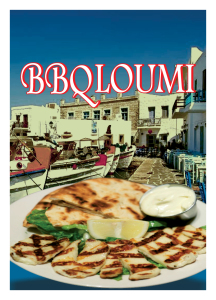Locations
This came after the CJEU held in a judgment that the General Court had failed to consider the interdependence of relevant factors when determining the likelihood of confusion between the collective mark and the application for BBQLOUMI (see our blog on the CJEU ruling: Does BBQing your HALLOUMI make a difference? – CJEU delves into the latest collective marks' issue).
Previous decisions
The dispute at hand started in 2014 after a Bulgarian company applied for an EU trade mark (EUTM) with the word BBQLOUMI and a figurative sign (picture below) covering goods and services in classes 29, 30 and 43 including cheese. This was opposed by the Foundation for the Protection of the Traditional Cheese of Cyprus named Halloumi (the "Foundation") that own an EU collective trade mark for the word HALLOUMI.

After the EUIPO dismissed the opposition, the case went all the way to the CJEU. It agreed with the EU General Court that earlier collective marks must be assessed in the same manner as earlier individual marks, and therefore distinctiveness is required for collective marks in the same way as it is for all marks.
The CJEU also agreed on the factors the court had laid down in order to assess the likelihood of confusion between the marks under Article 8(1)(b) of the EUTM Regulation No. 207/2009. These included the function and weak distinctiveness of the HALLOUMI mark, the identity and similarity between the goods covered by the marks and the low degree of visual, phonetic and conceptual similarity between the marks. The CJEU however concluded that the General Court had failed to look at the interdependence between these factors when reaching its decision, and set aside its decision.
General Court's revised decision
The CJEU referred the case back to the General Court to reassess the case. Following the extended guidelines from the CJEU, the General Court upheld the previous decision of the EUIPO and dismissed a likelihood of confusion between the two marks. It did so on the grounds that a likelihood of confusion presupposes both that the marks at issue are identical or similar and that the goods or services which they cover are identical or similar.
As regards the comparison of the goods and services, it found that there was no likelihood of confusion in respect of the “meat extracts” and “catering services” covered by the mark applied for, since they were neither identical nor similar to the goods covered by the earlier mark. Just in regard to “cheese” a likelihood of confusion could not be ruled out.
Concerning the similarity of the signs in question, the General Court saw no likelihood of confusion since there was a low degree of similarity of the signs in question. Even though both signs share the element “loumi”, the public will be more drawn towards the first part of the word “bbq”. Together with the figurative element of the mark, which pictures a barbeque scene, the consumer relates more to that theme than to the cheese. It is also unclear whether the barbequed white stripes in the picture are in fact halloumi cheese. Therefore, this outweighs the above-mentioned possibility of confusion.
In addition, the General Court held that the first mark had a low degree of distinctiveness since the consumers will not associate it with the commercial origin of the product, but simply with the type of cheese that is being sold to them. On top of that, the goods in question are everyday goods to which the consumer will show an average degree of attention when purchasing them.
(The General Court's decision can be found here, together with its press release.)
Comments
This decision outlines again the criteria a trade mark has to fulfil in order to prevent competitors from entering their market segment and confirms that collective marks should be assessed in the same way as individual marks. Companies that want to register a trade mark have to make sure that it is distinctive enough so that they can establish a high recognition value. This is an important factor in strengthening a business and its position in the market.
With special thanks to trainee, Fabia Breuer, for her contribution to this article.
